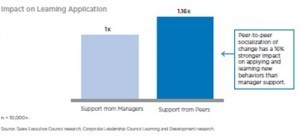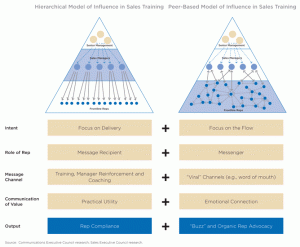Who Reps Really Listen to
The traditional method of driving change in an organization is the top-down approach—senior leadership sets the vision, and directions are cascaded down to the field. While it’s important to have strong leadership and vision in place, there’s only one problem—when it comes to behavior change, employees look to their peers more than they look to their superiors.
 CEB’s Corporate Leadership Council conducted a study to understand what enables employees to transfer knowledge they learn in the classroom into on-the-job performance (they call that “learning application). In that study, they found that support from peers has a 16% greater impact on learning application than support from managers. In other words—reps look to cues from their peers to help them apply (or not apply) new behaviors/strategies on-the-job.
CEB’s Corporate Leadership Council conducted a study to understand what enables employees to transfer knowledge they learn in the classroom into on-the-job performance (they call that “learning application). In that study, they found that support from peers has a 16% greater impact on learning application than support from managers. In other words—reps look to cues from their peers to help them apply (or not apply) new behaviors/strategies on-the-job.
While 16% may not seem like that big of a number, most organizations focus entirely on manager support. Yet how many of us have systematic methods of tapping into peer support for any given initiative?
 Now, you may be thinking “how systematically can you tap into informal conversations that happen between reps?” That’s a fair question. Leading edge companies have taught us to think very differently about the peer network, and they tell us there are a few ways that you can better tap into that key source of influence.
Now, you may be thinking “how systematically can you tap into informal conversations that happen between reps?” That’s a fair question. Leading edge companies have taught us to think very differently about the peer network, and they tell us there are a few ways that you can better tap into that key source of influence.
Ownership vs. buy-in: This is probably the most important of the keys to driving change. When people are included in a process, they feel ownership. If people are told what to do, they are inherently skeptical. So stop trying to create buy-in, and start trying to create ownership. But don’t just look at creating ownership of the solution, give reps ownership of the problem. Many companies will build new tools/technologies/platforms/ methodologies and test them with a select group of reps after they’ve been built. Few companies use reps from the onset—to understand why behaviors need to change, what the solution should be, and how to communicate it. Let them own it, and they’ll be more likely to apply it.
Give them something to talk about, in their terms: When companies build “buy-in” for change, it’s usually in practical terms. Here’s what it means for the company. Here’s what it means for your sales numbers. Here’s what you can do to make more money. The problem is, that’s not how sales reps talk, nor is that why people change. Reps don’t talk to each other about their paychecks, they talk in emotions. “How is my customer going to react to this?”, “Is this going to damage the relationship with my customer?”, “What happens if I can’t learn these new skills?”, “What might this mean for my job long term?”. You have to show them that the pain of same is much greater than the pain of change. SEC Members—use our Challenger Change Campaign Framework to build a change campaign that speaks to reps on their terms.
Understand where the influence lies (or, through whom the influence flows): Ask your sales managers who is the flag-bearer or standard-bearer of their team, and they’ll easily point you to one or two individuals that are the leaders of the team. Everyone else looks to them for social cues, and if that person is behind an initiative, the rest tend to follow. They are usually above-average performers, but not always the top performers on a team. These are critical people to create ownership with, as what they say and do will ultimately impact others on their team—for good and for bad.
Use market forces to create demand for change: “The forced march doesn’t get anyone excited. Tell someone they have to do something, they resist. Tell them they can’t have something, and they suddenly want it.” Several members, including ADP and Gen-i have realized that exclusivity or feeling left out breeds interest. Use the folks in #3 above in the “early adopter” phase—they’ll create some early wins and create momentum for new behaviors/initiatives.
SEC Members—we address these concepts, including exploring channels for how to tap into the peer influence, as part of our Challenger Skill Adoption workshop.
Have you had any initiatives that really captured the attention and buzz of the peer network (for good or for bad)? What do you think drove the engagement of the peer-to-peer network?
SEC Members, to learn more, review the key findings from the study and listen to the webinar replay.
Brent Adamson's Blog
- Brent Adamson's profile
- 9 followers



